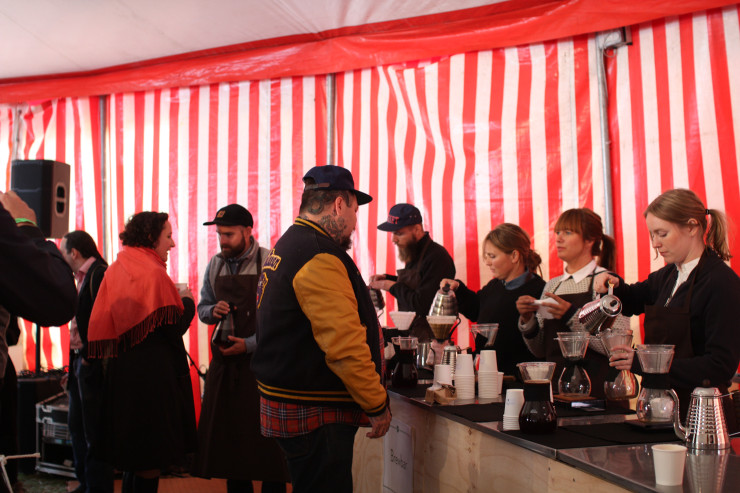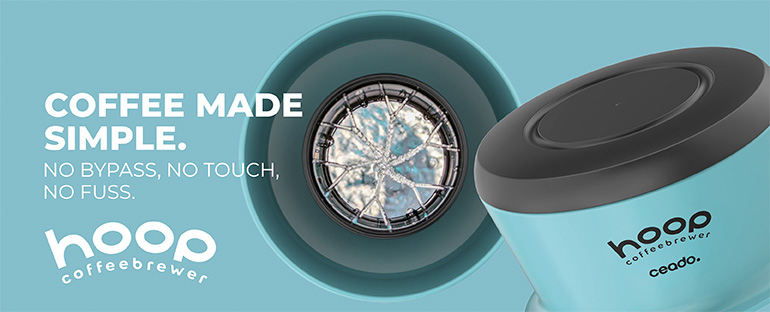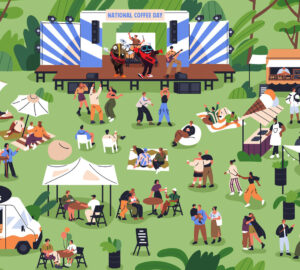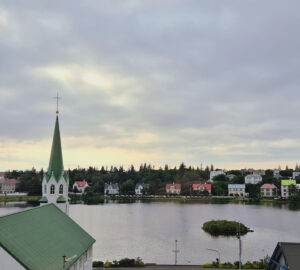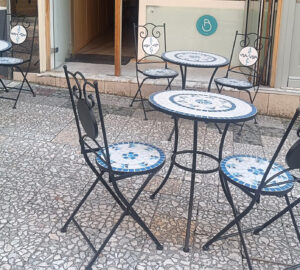On 25th and 26th August, Sprudge joined the epicurean masses at MAD Symposium, keen to see how the culinary and coffee industries would dovetail. Within both industries MAD plays host to people with levels of passion and skill beyond normalcy, the likes of which are rarely found together in one spot.
I arrived at 9am sharp to find an equally punctual and excited crowd. Tripping over hay bales and disembarking from boats, attendees cheerfully made their way towards a gleaming red tent on the grassy edge of Refshaleøen, Copenhagen. In a smaller candy-striped tent, refreshments were afoot. The day before, the coffee gang at MAD had begun preparing for the onslaught of over 600 attendees, dozens of speakers, honoured guests and the team from Noma. Inside the pinkish interior, breakfast service was hopping, with queues snaking outwards for shots of Drop Coffee and Koppi on two dominating, shiny Nuova Simonelli espresso machines. A nearby brew bar featured coffees from Workshop Coffee and Tim Wendelboe.
I was there on assignment to interview some of the assembled chefs, check out the coffee service, and take in the scene. So why not start at the top? During a small lull between brewing coffee and speaking to guests, Tim Wendelboe—the world-renowned barista and owner of the eponymous Tim Wendelboe roaster in Oslo, who personally manages the coffee experience at MAD—sat down to answer some questions.
We talked coffee, naturally. Wendelboe had just spent the past few days serving espresso to customers at Noma, using a one-group La Marzocco GS3 during the run-up to the symposium. Now the restaurant is looking at keeping the machine for service, with a permanent replacement to be installed by January 2015. Tim Wendelboe’s espresso selection for Noma was an Ethiopian espresso from the Duromina co-operative, which was replaced by the bright, cordial-like Gitwe espresso from Kenya for MAD.

Wendelboe pulled no punches for the affair, brewing his own roasting company’s take on the famed (and famously expensive) Panama Hacienda Esmeralda. This was classic geisha coffee, with a tremendous sweetness and floral honey overtones that had us swatting the wasps away. Cup in hand, Wendelboe explained how coffee at MAD Symposium began.
“Jens Nørgaard and I were here at MAD2, watching The Coffee Collective serve coffee to queues a mile long, using one two-group [espresso] machine and a French press service,” he told me. “I couldn’t get a coffee.” His growing relationship with Noma impelled him to act: “I was already in dialogue with Mads (Kleppe) about their coffee service at Noma, so I said to Jens. ‘we have to offer our services’—and it turned out those services were very welcome.” Jens Nørgaard and Tim Wendelboe duly rolled their sleeves up and took on the task.

Nørgaard had long-established coffee and restaurant industry relationships in Copenhagen as the owner of Cafe Europa, in addition to a decade of service as Chairman of the Board for Nordic Barista Cup (an event that is currently, and sadly, on hiatus). “We took the Coffee Common model,” Wendelboe told me. “We wanted a kind of Nordic Coffee Common, very little branding and an emphasis on quality. We took control of everything; sponsorship and equipment and organisation.”
This year’s sponsorship and roastery presence was decided by cupping samples from 17 applicants, a private and no doubt opinionated affair that took place in Oslo at Wendelboe’s Nordic Approach headquarters. Each entrant could apply for Gold and Silver sponsorship. Gold meant having your presence at MAD, with your own staff providing a coffee service and presence at the event’s coffee bars. Silver designation was reserved for coffees showcased in the Marco Beverage Filtro Shuttle-topped stalls all around the venue–full of batch brewed coffee, easily accessible, and accompanied by labelled cups that contained information on the coffee & roastery.
Exhibiting one’s coffee at MAD is no small feat, and Wendelboe shared with me that “some roasteries applied only for Silver; it’s a financial decision.” Due to harvest seasonality, coffees grown in Kenya and Ethiopia dominated the service at MAD, roasted by a roster of companies from around the world, including Calgary’s Phil & Sebastian Coffee Roasters and Mecca Espresso, hailing all the way from Sydney.
Wendelboe’s modus operandi is straightforward: “I want chefs to be excited by coffee; coffee as a culinary product rather than just fuel between service. I think the restaurants and customers deserve it.” To that end, let’s learn more about some of the featured roasters and their experiences at MAD.
The roasters in situ at MAD:
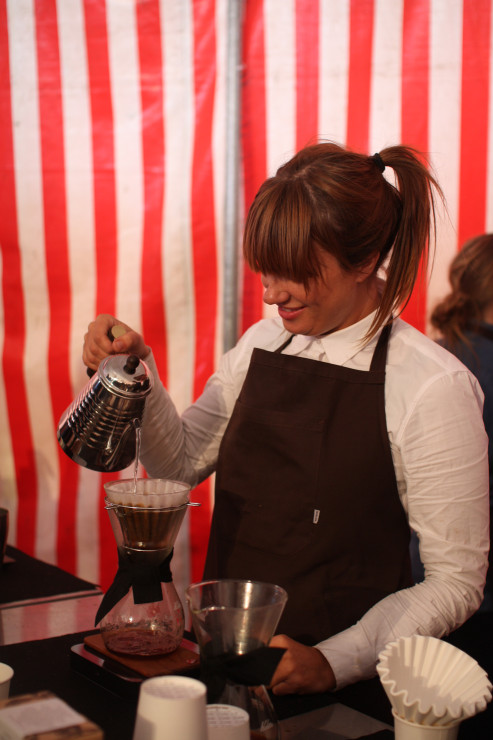
Joanna Alm co-owns and roasts at Drop Coffee in Stockholm. She won the first Swedish Roasting Championships this year, placing third in the world at Rimini this summer; her company was also named Notable Roaster for 2014 in this website’s annual awards feature. The decision to appear at MAD4 was a no-brainer. As Alm told me, “if MAD is asking us to come and brew coffee, there was no chance I’d say no to that.”
Drop’s espresso this year was a light-as-filter Ethiopian Hunkute, drawing out a 40g yield from a 20g dose for a lively, seriously sweet black currant cup. Benjamin Norman of Drop poured me a remarkable Kalita-brewed Wote, also Ethiopian–a sparklingly citrusy and perfumed cup.
Joanna Alm considers a presence in high-end restaurants to be appealing in the future, but their work at MAD Symposium this year is to “show what we are doing and to have people listening to you… it’s about all of those people drinking our coffee, having a chance to try our coffee” rather than showcasing the company itself.
She elaborated: “If we go home with ten accounts, great, but that’s not the result we necessarily aim for. It’s not a fair, a trade show…it’s not a salesperson’s element. All we are doing is showing the restaurant business what the coffee business can be.” On the current state of quality coffee making it into the fancier restaurants in her city, she admits Drop is still learning the ropes. “It’s others who are on the edges of speciality coffee that are really into the restaurant business and they know how to talk,” she told me. “We have never gotten heavily into sales in restaurants.” This sparks a discussion on who approaches who–small roasteries don’t often wield the chunks of time and money it takes to get restaurant coffee right–but Alm is firm that she would “make the time,” and that meeting chefs at MAD could be a catalyst for that.
“To get to know the chefs,” she tells me, “there’s no one who finds it easier than a roaster, who can talk about flavour. It’s about building a relationship–as soon as you talk to each other about flavour, it’s so easy to understand each other; it’s exactly the same language.”

Meanwhile for Anne Lunell, co-owner and roaster at Koppi in Helsingborg, Sweden, developing a relationship with customers and restaurants alike is meant to be personal. “Deliberately slow-growing” is how she describes Koppi’s place in the restaurant world, and their wider mantra. “We serve the coffee we enjoy the most,” she tells me, “and we stand by it.”
Koppi currently supplies coffee to 8 restaurants across Europe; each one receives a visit from Koppi a few times a year. She and fellow co-owner Charles Nystrand are careful and considered when it comes to supplying restaurants: “We’re building strong relationships. I think I wouldn’t want to push our coffee on people. We want to build a dialogue and create long-term relationships when opening up a coffee programme.”
Amass restaurant, fixed in the same area of Copenhagen as the Symposium, is one such example. Bo Bratlann, restaurant manager and sommelier at Amass told me a bit more about his restaurant’s coffee service. “We started with good coffee,” Bratlann says. “That’s your starting point. We only use Koppi, in a Hario V60, always keeping in line with seasonality.” In Lunell and Nystrand, Mr. Bratlann and the team at Amass have found more than just roasters; they’ve found a partnership, a support system to help make good coffee at Amass a reality. This relationship is a fine example for how roasters can reach chefs and sommeliers, and perhaps a template for some of the other potential partnerships being forged at MAD.

Koppi served two coffees from Costa Rica in the MAD tent: the aforementioned Monte Copey espresso and the exceptionally fruity Santa Rosa as pourover—the latter so tropical and sweet, that Lunell noted, “Tim [Wendelboe] actually thought it was a Kenyan on the cupping table.”
Is being at MAD this and last year benefiting Koppi? Definitely–but it’s more grow than show. “We’ve had a few really interesting chats today,” Anne Lunell told me. “But it’s hard to know what one new customer will bring; it all matters. You can’t place a value on being here.”

Richard Shannon, self-titled “grand master bean-browner” of London’s Workshop Coffee is also here for a second time.
This year Workshop served up a coffee from Kenya marked as Githiga AA–“undoubtedly the best filter coffee in our current range,” as per the bean-browner–brewed using a Hario V60 pourover filter. They also served coffee from a much-loved farm in Colombia called Finca Tamana, sourced via Nordic Approach.
Shannon, a repeat visitor, paused when I asked him whether chefs seemed more engaged in the coffee service this year. “I think so; we’ve been so busy it’s hard to engage as much as we’d like.” The difference in pace is tangible from last year, with MAD attendees eventually consuming 8,000 cups of coffee, up from around 6,000 last year. Shannon is pleased about raised awareness in general: “We’ve had lots more people going ‘Oh yeah, I know you guys. I’ve been to your cafe’.”
I later bumped into Alex Kratena, head bartender at The Langham, a luxurious hotel in West London. Kratena is a frequent visitor to Workshop’s Fitzrovia and Marylebone branches and was pleased to see his local favourites at MAD. When working at the hotel, he is more likely to travel outside its confines to seek “flavour and pleasure.” He says “in the Langham we have a gap; we sell a lot of coffee but when you see, like this, quality coffee executed with love, it’s inspiring”.

Richard Shannon echoes each of the other roasters when asked what made Workshop take up with MAD:
“We’re here for the exposure, definitely–not just as a company but for the industry itself.” Though he jokingly reckons they face a mixed crowd. “I’m guessing the Nespresso incidence amongst these guys is high.”
Perhaps, but not as high as it once was.
Nico Halliday is a Sprudge.com contributor based in London. Read more Nico Halliday on Sprudge.












